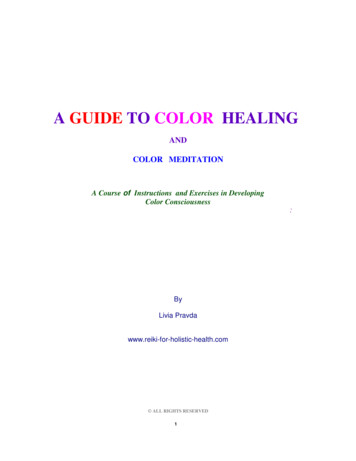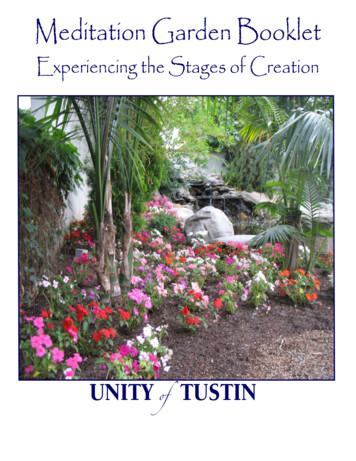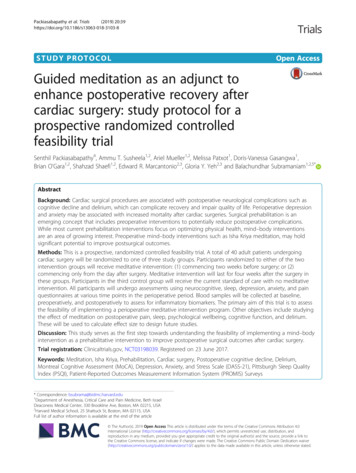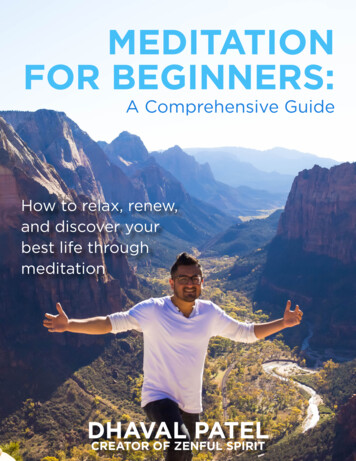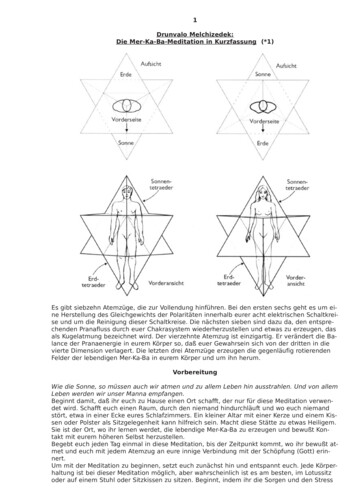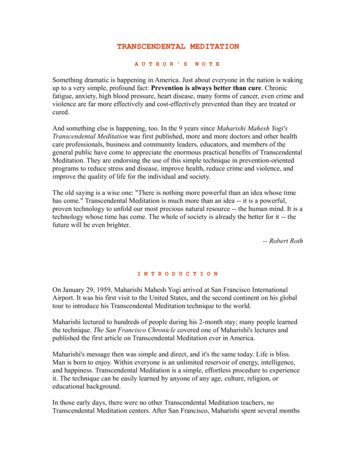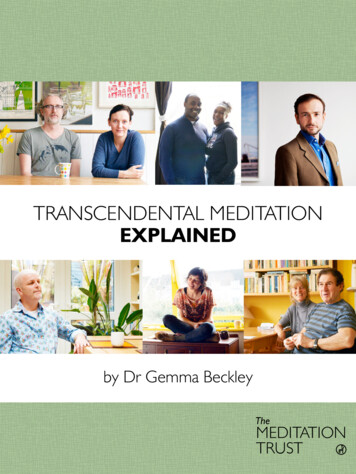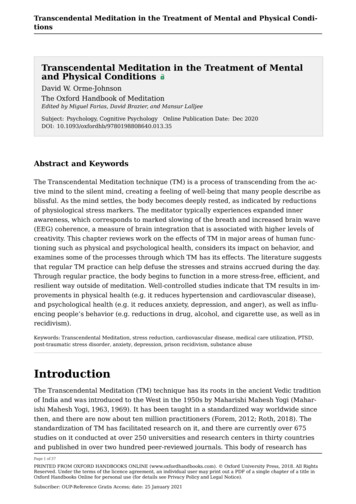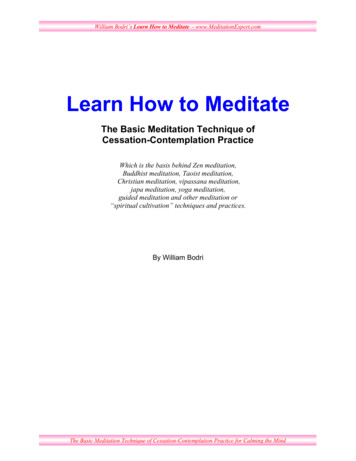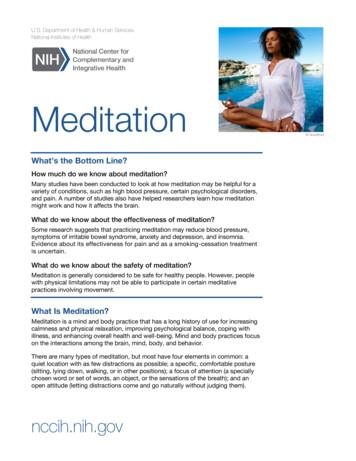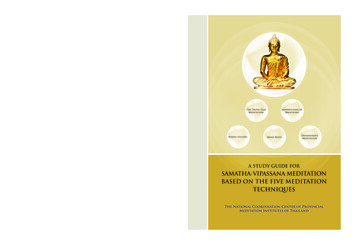
Transcription
Phra Ajarn Mun Bhuridatta-theraPhra Mongkol-Thepmuni (Sodh Candasaro)www.dhammacenter.orgA STUDY GUIDE FORSamatha (concentration) removes the five mentalHindrances and prepares the mind for wisdom(paññā), insight wisdom (vipassanā-paññā) andsupra-mundane wisdom (lokuttara-paññā). Whenwrong view, defilements, craving and attachment– the causes of suffering – are eliminated bysamatha and vipassanā, the suffering subsidesand eventually extinguishes automatically.SAMATHA-VIPASSANA MEDITATION BASED ON THE FIVE MEDITATION TECHNIQUESMaintaining self or mind is supreme in this world.If one governs the mind one will attain Dhamma[natural phenomena and the noble truths]. Tosee one’s own mind is to see Dhamma. To knowone’s mind is to know all Dhamma. To overcomethe mind is to achieve Nibbana. The mind isa noble treasure. One should not overlook it.The Triple GemMeditationRising-FallingMindfulness ofBreathingMind-BodyDhammakayaMeditationA STUDY GUIDE FORSAMATHA-VIPASSANA MEDITATIONBASED ON THE FIVE MEDITATIONTECHNIQUESThe National Coordination Center of ProvincialMeditation Institutes of Thailand
NAMO TASSA BAGAVATO ARAHATOSAMMA SAMBUDDHASSAHOMAGE TO THE LORD,THE EMANCIPATED,THE ALL ENLIGHTENED BUDDHAI
A STUDY GUIDE FORSAMATHA VIPASSANĀ MEDITATIONBASED ON THE FIVE MEDITATION TECHNIQUESPublished byThe National Coordination Center of ProvincialMeditation Institute of Thailand,Wat Luang Phor Sodh Dhammakaramwww.dhammacenter.org bmi@dhammacenter.orgISBN : 978-974-7533-44-6First Edition: March 6th 2012 (4,000 copies)Copyright c 2012No part of this publication may be reproduced or transmitted in any formwithout the prior permission of the publisher.Petkaserm Printing Group Co., Ltd.Nakorn Pathom, ThailandTel: 66 034-259-758, Fax: 66 034-253-465www.pkprinting.comII
HIS HOLINESS SOMDEJ PHRA NYANASANGVARASangharaja SakalamahasanghaparinayakaThe Supreme PatriarchIII
HIS HOLINESS SOMDEJ PHRA BUDDHAJARNPresident of Sangha Body Conference,Acting Sangharaja Committee, Chief of East Sangha Region,Abbot, Wat Saket Rajamahavihara, Bangkok, ThailandIV
HIS HOLINESS SOMDEJPHRA MAHARAJAMANGKALAJARNActing Sangharaja Committee Member of Sangha Body,Chief of North Sangha Region,Abbot, Wat Paknam Basijareaon, Bangkok, ThailandV
HIS HOLINESS SOMDEJPHRA BUDDHACHINNAWONGCommittee Member of Sangha Body,Chief of Central Sangha Region,Abbot, Wat Pichaiyat, Bangkok, ThailandVI
FOREWORDPhra Thepyanmongkol, the President of the National Coordination Center of Provincial Meditation Institute of Thailand, and itscommittee members have made a resolution to publish, A Study Guidefor Samatha-Vipassanā Meditation based on the Five MeditationTechniques, as a book. Those five techniques are (i) the Triple GemMeditation (Buddho); (ii) Mindfulness of Breathing (ānāpānasati);(iii) Rising-Falling (inflating-contracting); (iv) Mind (nāma) and Body(rūpa); and (v) Dhammakaya Meditation (sammā arahang). The purpose for this publication is a study guide for right practice of the LordBuddha, based upon these five meditation techniques. A meditator independently practices any one of these, based upon one’s own temperament.The book has been completed and published as a book forDhamma dissemination and the great benefits to our beloved Buddhistswho are seeking for the right practice.The information of this publication was collected from five different mediation centers before being translated into English. I agreethat this book will be of great benefit for those who study and practicesamatha-vipassanā meditation, based on their own temperaments. Moreover, the book, A Study Guide for Right Practice of the Three Trainingsbased on Visuddhimagga, which has been published before, is highlyrecommended for meditators to study, along with this book, for leadingstraightly (ujupa ipanno) and rightly (ñāyapa ipanno) to the Right Practice of Lord Buddha and to ultimate achievement or Nibbāna.I would like to congratulate everyone for this success, especially,Phra Thepyarnmongkol, the President of the National CoordinationCenter of Provincial Meditation Institutes of Thailand, who encouragedsupporting the publication.VII
Finally, with the Power of the Triple Gem, I would like to wisheveryone to prosper in the Teaching of Lord Buddha with the RightPractice for escape from the triple round (rounds of defilements, kammaor karma and results) and attainment of Paths (magga), Fruits (phala)and Nibbāna. And, I wish all may have a long life, good looks, Happiness, Health, Wisdom and good fortune. May whatever you so wish forbe yours.Somdej Phra MaharajamangkalajarnActing Sangharaja Committee Member of the Sangha Body,Chief of the North Sangha Region, Chief of Pali Studies,Chairman of the Advisory Board of the National Coordination Centerof Provincial Meditation Institutes of Thailand,Abbot of Wat Paknam Basicareon, BangkokVIII
ADVISORY & EXECUTIVECOMMITTEE FOR THE BOOKCHAIRMAN OF ADVISORY COMMITTEESomdej Phra Maharajamonggalajarn,Wat Paknam Bhasicharoen, Bangkok.ADVISORY COMMITTEEPhra Brahmavachirayan, Wat Yannawa, Bangkok.Phra Visuddhiwongsajarn, Wat Paknam Bhasicharoen, Bangkok.Phra Dhammakittiwong, Wat Rajorasaram, Bangkok.Phra Dhammapariyatvede, Wat Phra Pathom Jedi, Nakorn Pathom.Phra Dhammakosajarn, Wat Prayun Wongsawat, Bangkok.Phra Rajbrahmathera, Wat Paknam Bhasicharoen, Bangkok.CHAIRMAN OF EXECUTIVE COMMITTEEPhra Thepyanmongkol,Wat Luang Phor Sodh Dhammakayaram, Rajchaburi.EXECUTIVE COMMITTEEPhra Mongkolwattanakhun, Wat Pa Salawan, Nakornrajsima.Phra Sriyansobhon , Wat Rama IX Karnchanapisek, Bangkok.Phra Maha Pamoth Pamodito, Wat Luang Phor SodhDhammakayaram, Rajchaburi.Phra Maha Sagda Sumano, Wat Pa Visuddhikhun, Petchaburi.IX
Translated from Thai Version ofA STUDY GUIDE FOR SAMATHA VIPASSANĀMEDITATION BASED ONTHE FIVE MEDITATION TECHNIQUESISBN: 978-974-401-963-9Published byThe National Coordination Center ofProvincial Meditation Institute of ThailandX
EDITORS AND TRANSLATORSPhra Maha Wannapong Wannawangso, Pali Grade 9,(M.Sc. Eng.), Oregon State University, OR, USA),Phra Khru Baitika Dr. Barton Yanathiro(Ph.D. in Social Psychology, Cornell University, NY, USA.)Phra Maha Natpakanan Gunanggaro(MBA, Eastern Washington University, WA, USA),Mr. David Dale Holmes(Ph.D [ABD], Ludgwig Maximilians University, Germany)Ms. Eunice E. Cerezo(BA, Chico State University, CA, USA)Mr. Sakrapan Eamegdool(BSBA Business Management, Boston University, MA, USA).Mr. Watcharapol Daengsubha(BA in Management, Mahidol University International College,Nakhon Prathom, Thailand),Ms. Jessica Dawn Ogden(BA in Management, Lakeland College, A.B., Canada).COVER AND GRAPHIC DESIGNSMr. Phakakorn MuangnilXI
VENERABLE PHRA THEPYANMONGKOLPresident, the National Coordination Center of ProvincialMeditation Institutes of Thailand,Abbot, Wat Luang Phor Sodh DhammakayaramXII
ACKNOWLEDGEMENTThe National Coordination Center of Provincial MeditationInstitutes of Thailand was established with the commitment of Directors from 338 Meditation Centers (out of over 400) invited by theNational Buddhism Organization to a conference at Wat Yannawa,Bangkok, April 23-25, B.E. 2551 (2008). There were five objectives.Three were established at the conference and the last two were added later.1. To support the Sangha Body’s Provincial Meditation Centers to administer Buddhist Education effectively,2. To cooperate with Provincial Meditation Centers to teachmeditation at the same high standard for all people at all levels,3. To assist Provincial Meditation Centers with academicscholarship.4. To cooperate with the Chiefs of the Sangha Regions andDirectors of the Provincial Meditation Centers to raise academic training techniques to the same high standard.5. To support the Sangha in stabilizing, protecting and developing Buddhism under the rules of the Discipline, the Law and the SanghaRules.The committee members agreed to publish A Study Guide forSamatha-Vipassanā Meditation based on the Five Meditation Techniques, as a book. Those five techniques are the Triple Gem Meditation (buddho), Mindfulness of Breathing (ānāpānasati), Rising-Falling(inflating-contracting), Mind (nāma) and Body (rūpa), and Dhammakaya Meditation (sammā arahang). The purposes for this publicationwere for disseminating the Right Dhamma Practice to the directorsand meditation masters of Meditation Centers across Thailand andBuddhists worldwide who study and practice the Right Practice ofLord Buddha, and, most importantly, for all meditators independentlypracticing any one of these based on one’s own temperament.XIII
The book has been translated by Phra Maha NatpakananGunanggaro, and edited by Phra Maha Wannapong Wannavanso,David Dale Holmes, Eunice E. Cerezo, Mr. Sakrapan Eamegdool,Mr. Watcharapol Daengsubha, and Ms. Jessica Dawn Ogden. Pleaseaddress any questions or comments to www.dhammacenter.org.I would like to thank everyone for their strenuous efforts andto congratulate them on this successful contribution to the promulgation of the Dhamma. May these meritorious actions lead all to haveprosperity of life and to achieve the Paths, Fruits and Nibbana. May LordBuddha bless you all, as well as your meritorious work.Phra ThepyanmongkolPresident of the National Coordination Centerof Provincial Meditation Institutes of Thailand,Director of the Meditation Center of Rajburi Province, andAbbot of Wat Luang Phor Sodh Dhammakayaram.XIV
CONTENTSsamatha-vipassanameditationThe Triple Gem Meditation (Buddho)1-1Mindfulness of Breathing (ānāpānasati)2-1Rising-Falling (inflating-contracting)3-1Mind (nāma) and Body (rūpa)4-1Dhammakaya Meditation (sammā arahang)5-1appendixGlossaryA-1Resolution for a Successful LifeA-14Biography of Phra ThepyanmongkolA-18Wat Luang Phor Sodh DhammakayaramA-21The History of the National CoordinationCenter of Provincial MeditationInstitutes of ThailandA-23XV
Natthi jhāna apaññassaNatthi paññā ajhāyatoYamhi jhānañca paññā caSa ve nibbānasantike.There is no jhāna (absorption factors) for onewho is without wisdom and no wisdom for onewho is without jhāna. He who has both jhānaand wisdom is, indeed, close to Nibbāna.(Khuddaka-nikaya 25/35/65)XIV
THE TRIPLE GEM MEDITATION 1 - 1THE TRIPLE GEM MEDITATIONBYPHRA NYANVISITH SAMIDDHI VIRAJARN PHRA AJARN SING KHANTAYAGAMO Wat Pa SalawanANDMEDITATION INSTRUCTIONBYPHRA AJARN MUN BHURIDATTOTranslated byPhra Maha Natpakanan GunanggaloEdited byPhra Maha Wannapong Wannawangso,Mr. David Holmes,Ms. Eunice E. Cerezo.Original �คมน และ �าวนาสายพุทโธTHE TRIPLE GEM MEDITATIONNakornrajsima
BUDDHO1 - 2 SAMATHA-VIPASSANA MEDITATIONPHRA NYANVISITH SAMIDDHI VIRAJARN
THE TRIPLE GEM MEDITATION 1 - 3CONTENTS1. THE TRIPLE GEM MEDITATION661.2 Imparting the Truth71.3 Homage to the Buddha, Dhamma and Sangha81.4 Taking the Three Refuges81.5 Recollection of Lord Buddha’s Virtues91.6 Recollection of Doctrine91.7 Recollection of Sangha101.8 Purifying the Triple Gem101.9 Daily Chanting and Meditation111.10 Developing Loving Kindness (Mettā)121.11 Developing Compassion Meditation131.12 Developing Sympathetic Joy Meditation131.13 Developing Equanimity Meditation131.14 Paying Homage to the Triple Gembefore Meditation142. BHĀVANĀ (MEDITATION)152.1 Sources of Bhāvanā152.2 Types of Bhāvanā162.3 Three Stages of Meditation162.4 Samatha Meditation172.5 One 84,000 Dhamma-khanda172.6 Virtues for Meditation18THE TRIPLE GEM MEDITATION1.1 The Triple Gem as Refuge
1 - 4 SAMATHA-VIPASSANA MEDITATION3. THE PRACTICE3.1 Priliminary Pracitce183.2 Meditation Practice193.3 Bhavanga223.4 Exiting Meditation254. ARIYA-MAGGA-SAMANGĪBUDDHO18274.1 Magga, Ariya-magga, Phala and Ariya-Phala274.2 Walking the Mundane Path284.3 Creating Ariya-magga294.4 Ariya-magga-samangī304.5 Ariya-phala315. WALKING MEDITATION326. SIGNS OF MEDITATION (NIMITTA)336.1 The Three Signs336.2 Developing the Nimitta-samādhi366.3 Ñātapariññā366.4 Tīra apariññā396.5 Developing the External Patibhāga-nimitta396.6 Developing the Internal Patibhāga-nimitta406.7 Contemplation of 32 Parts of the Body416.8 Contemplation of Skeleton436.9 Contemplating at the Center446.10 Developing Pahāna-pariññā44
THE TRIPLE GEM MEDITATION 1 - 57. MEDITATION INSTRUCTION GIVENBY PHRA AJHAN MUN BHURIDATTO487.1 Benefits of Meditation487.2 Sīla (Morality)497.3 Knowing Oneself507.4 Developing Wisdom517.5 Arahant51THE TRIPLE GEM MEDITATION
BUDDHO1 - 6 SAMATHA-VIPASSANA MEDITATION1THE TRIPLE GEM MEDITATIONWith deep compassion, Lord Buddha imparted his lasting teachings to the world and offered the perfect discipline through the TripleGem Meditation. However, during the time of the Buddha, the teachingsfor this style of meditation were not yet well-established, where the practice could be imprinted with compassionate endurance. Therefore, I (theauthor), would like to provide a foundation that will uphold the TripleGem Meditation for practicing Buddhists of today and tomorrow.1.1 THE TRIPLE GEM AS REFUGEGenerally, Buddhists may be classified into four main categories:(1) Monks and novices, (2) Nuns and female novices, (3) Laymen, and(4) Laywomen.These four groups practice the teachings to declare themselvesas those who take refuge in the Triple Gem.After Lord Buddha finished giving His compassionate sermonto King Pimpisara, along with his 110,000 companies, and the youngman Singala, King Pimpisara and the 100,000 companies attainedsotapatti-phala or stream entry. Another 10,000 took the Triple Gem astheir refuge.
THE TRIPLE GEM MEDITATION 1 - 7After the sermon, the young man Singala, then, made a vow totake refuge in the Triple Gem by announcing:Esāha bhante suciraparinibbutampi ta bhagavanta sarana gacchāmi dhammañcabhikkhu-sa ghañca upāsaka (upasika ) ma sa gho dhāretu ajjatagge pā upeta sarana gata .Tatiyamti Esāha . ajjatagge pā upeta sarana gata Even though Lord Buddha made the Great Decease a long time ago, I take Him, His Dhamma,and the Noble Disciples as my refuge, recollection and respect forever. I would like the Sanghato recognize me as a layman [a laywoman] fromnow until I die.For the second time .For the third time .With the teachings the Lord Buddha gave to the sixty Arahants(Perfect Ones) at the Isipatanamigadaya Forest, near the city of Paranasi,He sent them to declare the Triple Gem method and to conduct ordination to all followers. Currently, the Triple Gem method of meditation istaught to laymen, laywomen and is also used for novice ordination.1.2 IMPARTING THE TRUTHMeditation masters of the Triple Gem method teach their students to honor their vow and adhere to the truth in the Triple Gem asfollows:THE TRIPLE GEM MEDITATIONTutiyamti Esāha . ajjatagge pā upeta sarana gata .
1 - 8 SAMATHA-VIPASSANA MEDITATION1. Aspirants kneel down and prostrate by allowing the head,hands and feet to touch the ground three times. While sitting and kneeling, with hands in a prayer position, one declares one’s vow to take theTriple Gem as refuge.2. One declares oneself to take the Triple Gem for refuge by embracing the virtues of the Lord Buddha, the Dhamma and the Sangha.BUDDHO3. One declares one’s willingness to recall the virtues of theLord Buddha, the Dhamma, and the Sangha throughout one’s practice.4. One declares to uphold the truth and to respect the virtuesof the Lord Buddha, the Dhamma and the Sangha as one’s refuge withrecollection and respect from now until death.1.3 HOMAGE TO THE BUDDHA,DHAMMA AND SANGHAWhen the truth has been made, one recites out loud asfollows:Araha sammā-sambuddho bhagavā buddha bhagavanta abhivādemi (prostrate one time),Svākkhāto bhagavatā dhammo dhamma namassāmi (prostrateone time),Supatipanno bhagavato sāvakasangho sa gha namani(prostrate one time).1.4 TAKING THE THREE REFUGESBuddha sarana gacchāmi,Dhamma sarana gacchāmi,Sa gha sarana gacchāmi,Dutiyampi Buddha saranam gacchāmi,
THE TRIPLE GEM MEDITATION 1 - 9Dutiyampi Dhamma sarana gacchami,Dutiyampi Sa gha sarana gacchāmi,Tatiyampi Buddha sarana gacchāmi,Tatiyampi Dhamma sarana gacchāmi,Tatiyampi Sa gha sarana gacchāmi,I seek the Lord Buddha, the dhamma and the noble disciples asmy refuge, with recollection and respect for the teachings until death.Itipi so bhagavā araha sammā sambuddho vijjācara asampannosugato lokavidū anuttaro purisadammasārathi satthā devamanussāna buddho bhagavāti.Recite while making the five-point prostration:Kāyena vācāya va cetasā vāBuddhe kukamma pakata mayā ya Buddho pa igga hatu accayanta Kālantare sa varitu va buddhe.When finished, one rises.1.6 RECOLLECTION OF DOCTRINESvākkhāto bhagavatā dhammo sandi hiko akāliko ehipassikoopanayiko paccatta veditabbo viññūhīti.Recite while making the five-point prostration:Kāyena vācāya va cetasā vāDhamme kukamma pakata mayā ya Dhammo pa igga hatu accayanta Kālantare sa varitu va dhamme.When finished, one rises.THE TRIPLE GEM MEDITATION1.5 RECOLLECTION OF LORD BUDDHA’S VIRTUES
1 - 10 SAMATHA-VIPASSANA MEDITATION1.7 RECOLLECTION OF SANGHASupa ipanno bhagavato sāvakasa gho ujupa ipannobhagavato sāvakasa gho ñāyapa ipanno bhagavato sāvakasa ghosāmīcipa ipanno bhagavato sāvakasa gho yadita cattāri purisayugāniattha purisapuggalā esa bhagavato sāvakasa gho āhuneyyo pāhuneyyodakkhineyyo añjalīkara īyo anuttara puññakkhetta lokassāti.BUDDHORecite while making the five-point prostration:Kāyena vācāya va cetasā vāSa ghe kukamma pakata mayā ya Sa gho pa igga hatu accayanta Kālantare sa varitu va Sa ghe.When finished, one rises and prostrates three times. Aspirantsreturn to sitting on the floor with legs folded back. Holding two palmstogether at the prayer position, they listen to the teachings on how topractice the Triple Gem Meditation.Those who make a vow to aspire to the virtues of Lord Buddha,dhamma and sangha are Buddhists. Their obligation as laymen and laywomen is to practice the Teachings of Lord Buddha.1.8 PURIFYING THE TRIPLE GEMOne must be faithful with the Triple Gem as his or her truerefuge and recollection. When one is heedless, the virtues of the TripleGem are broken. The following are practices for keeping the Triple GemMeditation pure:1. One is well established in six respects by:a. Paying homage to Lord Buddhab. Displaying dedicated practice of the Dhammac. Being reverent towards noble disciples
THE TRIPLE GEM MEDITATION 1 - 11d. Having sustained awareness, not being heedless in one’spracticee. Maintaining practice of the three trainings – morality, concentration and wisdomf. Displaying of kind-reception or friendly greetings3. One does not become a cleric of another religion. One doesnot believe in non-Buddhist rituals, nor take them for refuge. If one does,the virtues of the Triple Gem are broken.4. One does not believe in Brahman rituals, such as horoscopesor exorcism. If one does, the virtues of the Triple Gem are broken.5. One believes in the law of karma, for example, when one doesevil, one will eventually receive evil due to unkind actions. Similarly,when one commits good actions, one will eventually receive good resultsdue to one’s kind actions. One does not believe in omens and prognostication. One must always sustain samādhi or concentration. Wheneverone lacks samādhi, the faith of the Triple Gem is broken. If one lacksfaith, the virtues of the Triple Gem become impure. One believes in theenlightenment of Lord Buddha as supreme.1.9 DAILY CHANTING AND MEDITATIONThe virtues of the Lord Buddha, Dhamma and Sangha arementally-achieved through cultivating one’s own mind. They are mentalrequisites for the practice of the Triple Gem.One cultivates one’s mind through diligently chanting and meditating each day.THE TRIPLE GEM MEDITATION2. One must abstain from being faithful to any guardian spirit.One does not respect evil spirits, devils, or guardian-spirits of variousplaces, celestial beings, spells, magic or any non-Buddhist knowledge.If one does, the virtues of the Triple Gem are broken.
1 - 12 SAMATHA-VIPASSANA MEDITATIONPathama yāma ca kamāya nisajja āvara iyehi dhammehicitta parisodheti. Before bedtime, one practices walking meditation,pays homage to the Triple Gem and develops the brahma-vihāras (thefour divine abidings). One meditates to calm and stabilize the mind intosamādhi before going to sleep.BUDDHOAddharatta ca kamāya nisajja āvara iyehi dhammehi citta parisodheti. One rises at midnight, because it is peaceful and tranquil.Next, one practices walking meditation, pays homage to the Triple Gemand develops the brahma-vihāras. One then meditates to ease and balancethe mind into samādhi before returning to sleep.Pacchima yāma ca kamāya nisajja āvara iyehi dhammehicitta parisodheti. Before dawn, one rises and cleanses one’s face. Next,one pays homage to the Triple Gem, develops the brahma-vihāras andmeditates to still and stabilize the mind while entering samādhi. One alsopractices walking meditation until dawn.1.10 DEVELOPING LOVING KINDNESS (METTĀ)Sharing Loving Kindness to OneselfAha sukhito homi. May I be happy.Niddukkho homi. May I be without suffering.Avero homi. May I be free from vengeance.Abyāpajjho homi. May I be free from ill will.Anīgho homi. May I be free from frustration.Sukhī attāna pariharāmi. May I be happy forever.Sharing Loving Kindness to OthersSabbe sattā sukhitā hontu. May all beings who are brothers inthe suffering of birth, old age, sickness and death be happy.
THE TRIPLE GEM MEDITATION 1 - 13Sabbe sattā averā hontu. May all beings who are brothers in thesuffering of birth, old age, sickness and death be free from vengeance.Sabbe sattā Abyāpajjhā hontu. May all beings who are brothers inthe suffering of birth, old age, sickness and death be free from ill will.Sabbe sattā anīghā hontu. May all beings who are brothers in thesuffering of birth, old age, sickness and death be without frustration.Sabbe sattā attāna pariharantu. May all beings who are brothersin the suffering of birth, old age, sickness and death be happy forever.Sabbe sattā sabbadhukkhā pamuñcantu. May all beings whoare brothers in the suffering of birth, old age, sickness and death be freefrom all suffering.1.12 DEVELOPINGSYMPATHETIC JOY MEDITATIONSabbe sattā laddhasampattito mā vigacchantu. May all beingswho are brothers in the suffering of birth, old age, sickness and deathnot lose their wealth.1.13 DEVELOPINGEQUANIMITY MEDITATIONSabbe sattā kammassakā. May all beings who are brothers in thesuffering of birth, old age, sickness and death have their own karma,kammadāyādā – have fruit of karmakammayonī – be born due to karmakammapandhū – be followed by karmakammapa isara ā – have karma as their refuge and dwellingTHE TRIPLE GEM MEDITATION1.11 DEVELOPINGCOMPASSION MEDITATION
1 - 14 SAMATHA-VIPASSANA MEDITATIONya kamma karissanti – commit to whatever karmakalyana vā pāpaka vā – good karma or bad karmatassa dāyādā bhavissanti – be the ones who consume the resultof their own karma.1.14 PAYING HOMAGE TO THE TRIPLE GEMBEFORE MEDITATIONBUDDHOEnshrine the Triple Gem with flowers, joss sticks (incense) andcandles:Yamaha sammāsambuddha bhagavanta sara a gato (gatāfor female). I take the Lord Buddha who is rightly self-enlightened asmy refuge for ending suffering.Iminā sakkārena ta bhagavanta abhipūjayāmi. I enshrine theLord Buddha with this homage (Prostrate).Yamaha svākkhāta bhagavatā dhamma sara a gato (gatāfor female). I take the dhamma which Lord Buddha has laid down as myrefuge for eliminating danger.Iminā sakkārena ta dhamma abhipūjayāmi. I enshrine thedhamma with this homage (Prostrate).Yamaha supa ipaññā sa gha sara a gato (gatā for female). I take the noble disciples of Lord Buddha who practice well asmy refuge for curing disease.Iminā sakkārena ta bhagavanta abhipūjayāmi. I enshrinethose noble disciples with this homage (Prostrate).
THE TRIPLE GEM MEDITATION 1 - 152BHĀVANĀ (MEDITATION)Bhāvanā is an effort that Buddhists widely accept as the rightand utmost practice. There is no better practice.2.1 SOURCES OF BHĀVANĀBhāvanā is derived from four efforts (sammappadhāna):2. Sa vara-padhāna, the effort to prevent all evil fromarising in mind.3. Bhāvanā-padhāna, the effort to develop wholesomenessor merit to arise in mind.4. Anurakkhanā-padhāna, the effort to maintain wholesomenessor merit in mind.Bhāvanā-padhāna, or the effort to develop merit, is the rightpractice of Buddhism. There is no better practice. It is the obligation ofBuddhists [monks, novices, laymen and laywomen] to practice bhāvanāpadhāna for the cessation of sa sāra [the round of rebirth], growth ofanalytic insight, a more profound understanding of the three Tipitaka(central teachings of Lord Buddha) and ultimate attainment of Nibbāna.It is impossible to end the suffering in the round of rebirth and achieveNibbāna without bhāvanā-padhāna.Bhāvanā-padhāna is the peak of right practices. Buddhists whopractice dāna or generosity, sīla or morality must practice bhavāna ormeditation. Buddhist monks and novices must establish all four effortsor Sammappadhāna with bhāvanā-padhāna as their foundation. Theypractice sīla, samādhi and paññā or wisdom without heedlessness.THE TRIPLE GEM MEDITATION1. Pahāna-padhāna, the effort to abandon or eliminateevil from mind.
1 - 16 SAMATHA-VIPASSANA MEDITATIONBhāvanā can be defined as the process of developing or becoming – teaching the mind, speech and body to cultivate sīla (morality),samādhi (concentration) and paññā (wisdom), developing the mind ofordinary persons to become noble disciples of Buddhism. At a higherlevel, bhāvanā is training one’s mind to become a Bodhisatta (a candidatefor becoming a Buddha), while moving towards full enlightenment, asLord Buddha did. With bhāvanā practice, the meditator becomes onewith dhamma-vinaya (dhamma and discipline) encompassing all 84,000dhamma-khanda (a unit of the doctrine).BUDDHO2.2 TYPES OF BHĀVANĀPhra Anuruddha categorized bhāvanā into two areas:1. Samatha-bhāvanā, developing mindfulness and awareness,purifying the mind from sensual desire and stabilizing the mind duringmeditation or samādhi,2. Vipassanā-bhāvanā, developing the mind, being endowedwith mindfulness, awareness and samādhi for the development of wisdom.Samatha-bhāvanā will be discussed first, followed by vipassanābhāvanā.2.3 THREE STAGES OF MEDITATIONIn Abhidhammattha-sangaha, Phra Anuruddha categorizedsamatha-bhāvanā into three categories:1. Preliminary Meditation (parikamma-bhāvanā), while meditating one mentally recites a selected word.2. Proximate Meditation (upacāra-bhāvanā), the mind is stablein proximate meditation.3. Attainment Meditation (appanā-bhāvanā), the mind is stablein attainment meditation.
THE TRIPLE GEM MEDITATION 1 - 172.4 SAMATHA MEDITATIONAll 40 meditation techniques are tools for developing concentration of mind. Practicing the 40 meditation techniques properly leadsmeditators to the noble paths and fruits.Some meditation masters, however, have confused students byteaching the 40 meditation techniques improperly. They have taughttheir students to learn all 40 meditation techniques by practicing onetechnique at a time.2.5 ONE 84,000 DHAMMA-KHANDALord Buddha is the Omniscient One and (vibhajjavādī) who categorized the five aggregates of Body and Mind. Thus, one human is bothdhamma and vinaya or the 84,000 dhamma-khanda merged into one.When the dhamma-vinaya is one piece, some teachers teach theirstudents differently. They do not teach them to merge the dhamma-vinayainto one. This is also considered wrong teaching.From another perspective, since no previous perspective wasgiven, new meditators do not understand development of samatha andvipassanā. If they gain a little concentration and knowledge, they maymisunderstand that they have attained insight knowledge or vipassanāñā a. Thus, they become misdirected, and rather than advancing tovipassanā, they remain in samatha meditation for an extended periodof time.Therefore, to understand the background of samatha, a briefexplanation is given:Lord Buddha knew precisely that teachable-beings are trappedin the cycle of rebirth, and they do not see the path to Nibbāna, the cessation of suffering.THE TRIPLE GEM MEDITATIONIt is wrongly-believed that if the meditator wishes to completeall 40 meditation techniques, he must complete one technique at a timein order to attain all 40. This is considered incorrect teaching.
1 - 18 SAMATHA-VIPASSANA MEDITATIONBUDDHOWhen Lord Buddha taught the veneyya (teachable beings) to befree from suffering and from the dangerous cycle of rebirth, He calmedtheir minds from defilements in order to direct them to the path ofNibbāna. This is the supreme path in the world. There is no better path.This path is secure from all conditions which bond world beings.To calm the mind from defilements and to direct one to the pathof Nibbāna are important in establishing a beginning for meditators.With His profound wisdom and great compassion, Lord Buddha knewand taught whichever of the 40 methods of meditation which was bestsuitable to an individual’s temperament, instead of teaching them all,one by one, until completing all 40. When the individual found the rightmethod, Lord Buddha, then, taught how to develop that method.New meditators will have, thus, practiced samatha and may,then, develop vipassanā which will be further explained.2.6 VIRTUES FOR MEDITATIONBuddhist meditators consistently observe sīla, keep a perfectdaily routine and have virtues of great support. The following three arevirtues of great support that meditators must cultivate repeatedly: (1)Appamādo amata pada , heedlessness as the immortal dhamma (2)Satimā parimukhasati , being mindful, and (3) Sampajāno, having fullawareness of one’s mental states3THE PRACTICE3.1 PRILIMINARY PRACITCEUpon taking their vows in the Triple Gem, laymen and laywomenundertake and uphold the five or eight precepts. They pay homage tothe Triple Gem, practice chanting, develop the four brahma-vihāras anddeepen their practice through meditation. p
VII FOREWORD Phra Thepyanmongkol, the President of the National Coordi-nation Center of Provincial Meditation Institute of Thailand, and its committee members have made a resolution to publish, A Study Guide for Samatha-Vipassanā Meditation based on the Five Meditation Techniques, as a b
